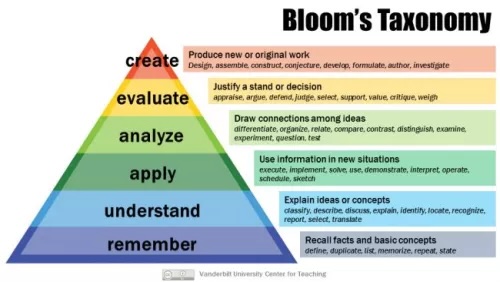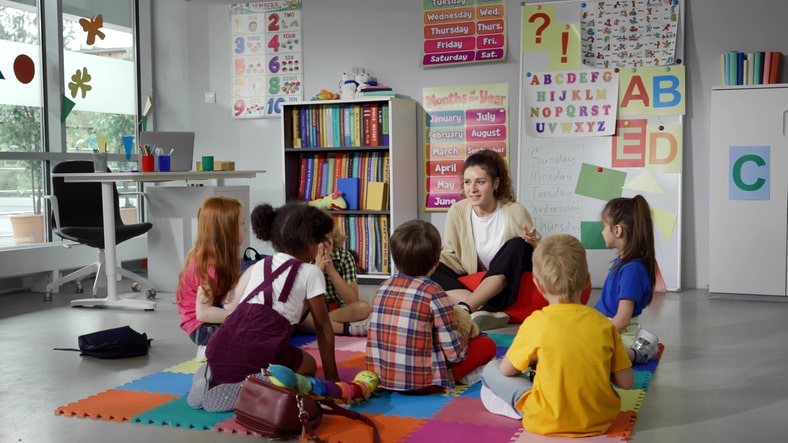
The 6 levels of questioning in the classroom according to Bloom's Taxonomy provide a structured shift from simple factual recall to more complex cognitive processes.
Teaching Strategies:The goal of questioning in the classroom is not simply to determine whether students have learned something, but rather to guide them in their learning process. Unlike tests, quizzes, and exams, questioning in the classroom should be used to teach students, not test them!
Teachers spend a great deal of classroom time testing students through questions. Observations of teachers at all levels of education reveal that most spend more than 90 percent of their instructional time testing students (through questioning). And most of the questions teachers ask are typically factual questions that rely on short-term memory.
Although questions are widely used and serve many functions, teachers tend to overuse factual questions such as “What is the capital of California?” Not surprising, as many teachers ask upward of 400 questions every school day! And approximately 80 percent of all the questions teachers ask are factual, literal, or knowledge-based questions.
The result is a classroom in which there is little creative thinking taking place.

Bloom's Taxonomy is a hierarchical model used in education to classify educational learning objectives into levels of complexity and specificity. It's named after Benjamin Bloom, who chaired the committee of educators that devised it in the 1950s.
The taxonomy has six levels, designed to help educators create more effective learning objectives and engage students in higher levels of thinking. These levels are arranged in hierarchical form, moving from the lowest level of cognition to the highest level of cognition.
Bloom's Taxonomy was revised in 2001 to better reflect the different types of cognitive processes used in learning and understanding.
Bloom's Taxonomy is a powerful tool in the K-12 classroom because it provides a structured approach to questioning that promotes higher levels of thinking. Instead of focusing on rote memorization, Bloom's Taxonomy encourages students to analyze, evaluate, and create. This level of questioning not only enhances students’ understanding of the material, but it also fosters critical thinking and problem-solving skills.
Moreover, this level of questioning in the classroom provides teachers with a clear framework to design their lessons and assess student learning effectively. This approach shifts the focus from merely testing students to facilitating meaningful learning experiences.

Graphic used with permission by Vanderbilt University
The first level of questioning in the classroom according to Bloom’s Taxonomy is "Remember" (previously: “Knowledge”). This base level involves recalling or recognizing information from memory. It's the most basic level of cognition, where students are asked to remember facts, terms, basic concepts, or answers without necessarily understanding what they mean.
Examples of this level of questioning in the classroom might include "What is the capital of France?" or "Who wrote 'To Kill a Mockingbird'?" Although this level is necessary, it's important to progress beyond it to promote higher levels of thinking.
Words often used in “Remember” questions often include know, who, define, what, name, where, list, and when.
Remembering question examples:
 Level 1 of Bloom" />
Level 1 of Bloom" />
The second level of questioning in the classroom is "Understand" (previously: “Comprehension”). At this stage, students are expected to comprehend the material, which means they can interpret, translate, and summarize the information.
This level goes beyond simple recall of facts and asks students to explain ideas or concepts in their own words.
Keywords often used in "Understand" questions include explain, describe, identify, discuss, and interpret.
Understanding questions examples:

The third level of questioning in the classroom, according to Bloom’s Taxonomy, is "Apply" (previously: “Application”). At this stage, students are expected to use the information they have learned in new situations.
This stage involves problem-solving, implementing methods, and demonstrating how concepts can be used in real-world scenarios.
This level of questioning is important because it encourages students to go beyond simply recalling information and understanding concepts and to start applying this knowledge in practical ways. It promotes critical thinking and problem-solving skills and helps students see the relevance and applicability of what they are learning.
Keywords often used in "Apply" questions include demonstrate, apply, solve, use, and illustrate.
Applying question examples:

The fourth level of questioning in the classroom is "Analyze" (previously: “Analysis”). This level involves breaking down information into its component parts for better understanding. Students are expected to differentiate, organize, and relate the parts to the whole.
This stage is crucial as it encourages students to examine information in a detailed way and to understand how different parts relate to one another. This level of questioning promotes critical thinking and a deeper understanding of the subject matter.
Keywords often used in "Analyze" questions include compare, contrast, examine, classify, and break down.
Analyzing questions examples

The fifth level of questioning in the classroom is "Evaluate" (previously: “Evaluation”). At this stage, students are expected to form judgments about the value and worth of information based on criteria and standards. This involves appraising, judging, critiquing, and defending positions. This level encourages students to formulate their own opinions and make judgments based on their understanding and analysis of the information.
Keywords often used in "Evaluate" questions include judge, rate, evaluate, defend, and justify.
Evaluating question examples:

The final level of questioning in the classroom according to Bloom’s Taxonomy is "Create" (previously: “Synthesis”). At this stage, students are expected to use what they've learned to create something new or original. This could involve developing a plan or proposal, deriving a set of abstract relations, or presenting an original idea. This level of questioning encourages creativity and innovation, as students are asked to generate new ideas, products, or ways of viewing things. Keywords often used in "Create" questions include design, construct, create, invent, and compose.
Creating question examples:

Many teachers think primary-level students (Kindergarten through 2nd Grade) cannot handle higher-level questions. But nothing could be further from the truth! Challenging all students through higher-order questioning is one of the best ways to stimulate learning and enhance brain development, regardless of age.
If you only ask your students one level of questioning, your students might not be exposed to higher levels of thinking. If, for example, you only ask your students knowledge-based questions, they might think that learning a specific subject is nothing more than the ability to memorize a select number of facts.
The 6 levels of questioning in the classroom according to Bloom’s Taxonomy provide a structured shift from simple factual recall to more complex cognitive processes. This approach not only deepens students' understanding of the subject matter, but also fosters critical thinking, problem-solving skills, creativity, and innovation.